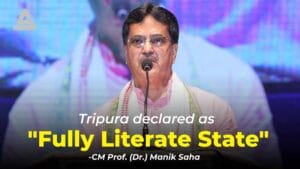Table of Contents
Facts About Ayodhya’s Ram Mandir
In Hindu mythology, Ayodhya served as the capital of the ancient Kosala Kingdom and holds immense significance as the birthplace of Lord Rama, a highly revered deity in Hinduism. The movement to build a temple on the site in Ayodhya, previously occupied by a mosque, traces its roots back to the 19th century. However, it gained substantial momentum in the 1980s, spearheaded by the Vishwa Hindu Parishad (VHP) and the Bharatiya Janata Party (BJP).
Subsequently, the Archaeological Survey of India (ASI) conducted investigations and uncovered evidence suggesting the presence of remnants of a Hindu temple at the disputed site. This archaeological finding added a historical dimension to the movement, further influencing the discourse surrounding the construction of a temple in Ayodhya.
The Ram Temple in Ayodhya is set to be consecrated on January 22, 2024. The upcoming event is anticipated to be a grand affair, with the participation of numerous eminent figures such as sages, politicians, actors, sportspersons, and other well-known personalities who have been invited to witness this historic moment. The construction of the Ram Temple has been a significant and prolonged endeavor, making the consecration a culmination of decades-long efforts in independent India.
The ceremony is expected to be massive, with approximately 4,000 saints representing various sects and an estimated attendance of around 8,000 people. The guest list, as shared by Trust Secretary Champat Rai, includes individuals from diverse fields such as politics, business, science, entertainment, and the military. As Ayodhya prepares to celebrate this monumental occasion, it is worth reflecting on some key facts about the Ram Mandir.
The Sacred Foundation:
- The base of the Ram Mandir is very special. It has soil from 2587 places, like Jhansi, Bithoori, Yamunotri, Haldighati, Chittorgarh, and the Golden Temple. Each speck of soil makes the temple holy and connects different regions spiritually.
Legacy of Sompuras:
- The builders of the Ram Mandir come from the famous Sompura family. They've built over 100 temples worldwide, including the revered Somnath Temple. Chandrakant Sompura and his sons Ashish and Nikhil continue a family tradition in temple architecture.
No Steel, No Iron, and a Millennium of Strength:
- The Ram Mandir is unique because it's built without steel or iron. Champat Rai, from the Trust, says using only stones ensures the temple lasts for a thousand years, showcasing the enduring strength of traditional construction.
Shri Ram Bricks:
- The bricks used in the temple have 'Shri Ram' written on them, a tribute to history. This echoes an ancient practice during the construction of Ram Setu. The modern bricks promise more strength and durability.
Integration of Shastras and Chaulukya Style:
- The temple's design follows Vastu Shastra and Shilpa Shastras. It's in the Gujara-Chaulukya style, combining ancient wisdom and beauty.
Soil from Thailand:
- Soil from Thailand is part of the consecration ceremony on January 22, 2024. This shows the universal importance of Lord Ram’s legacy, crossing borders.
Lord Rama’s Durbar:
- The temple has three floors covering 2.7 acres. The ground floor shows Lord Ram's life, and the first floor features his grand Darbaar, made with pink sandstone from Rajasthan.
Numbers Unveiled:
- The temple is 360 feet long, 235 feet wide, and 161 feet tall with 12 gates. It's a magnificent example of architecture.
Contribution of Holy River Waters:
- The consecration on August 5th had water from 150 rivers, symbolizing a spiritual union reflecting India’s diverse sacred waters.
Monetary Donations and High-Profile Support:
- The temple's construction received significant financial support from figures like Chief Minister Adityanath Yogi and others.
A Time Capsule for Posterity:
- A time capsule buried 2000 feet below the temple preserves information about the temple, Lord Ram, and Ayodhya for future generations.
Unresolved Survey on Mythological Temple:
- Surveys suggest the Babri Mosque was built on a pre-existing structure. The mix of myth and archaeology adds mystery to the site's history.
Exquisite Pillars and Nagar Style Design:
- The temple has 360 pillars in the Nagar style, giving it a unique and appealing look.
Additional Funds for Revamping Temple Town:
- The temple's construction has led to a plan to improve Ayodhya with projects worth 500 Crores, making it a cultural and spiritual hub.
Vision for the Future:
- The temple is 90% complete and expected to open in January 2024. It not only honors the past but guides future generations spiritually and culturally.
In conclusion:
The Ayodhya Ram Mandir is more than a building; it's a blend of faith, history, and great architecture. As it takes shape, it invites people to explore a narrative rich in spiritual heritage and cultural significance, with each part telling a story of its own.

Meghalaya Launches ‘She-Rise’: Northeast’s First Zero Waste Period Mission
Meghalaya’s first zero waste sanitary pad production unit ‘She-Rise’ under the Green Meghalaya Initiative is transforming menstrual hygiene, sustainability, and women’s empowerment in the North East.

Tripura Declared Fully Literate State: 95.6% Literacy Rate, Third in India
On 23 June 2025, Tripura was officially declared India’s third “Fully Literate State” with an impressive 96.5% effective literacy rate, driven by the ULLAS campaign and over 2,200 Youth Literacy Corps volunteers.

India AI Action Summit 2025: Championing Inclusive Global AI Governance
Discover how India's AI Action Summit 2025 is shaping inclusive global AI governance, focusing on equity, public input, and the Global Majority's voice in future tech regulation.

Juventus vs Wydad AC: 2025 Club World Cup Showdown Preview
Full preview of Juventus vs Wydad AC at the FIFA Club World Cup 2025: form guide, tactical breakdown, key players, broadcasting info, odds, and expert prediction

U.S. Bombs Iran Explained: Strikes, Timeline & Impact
An in-depth analysis of U.S. bombings of Iran: key incidents, “did the US bomb Iran today?”, Fordow nuclear site impact, Trump’s decisions, war risks, and expert FAQs.-STUDY247

Iran–US Conflict Explained: Attacks, Strikes, Nuclear Sites & Capabilities
An in-depth analysis of Iran–US tensions: key incidents, Fordow nuclear site, Tomahawk missiles, B2 bombers, bunker-buster bombs, and the risk of wider conflict.-STUDY247